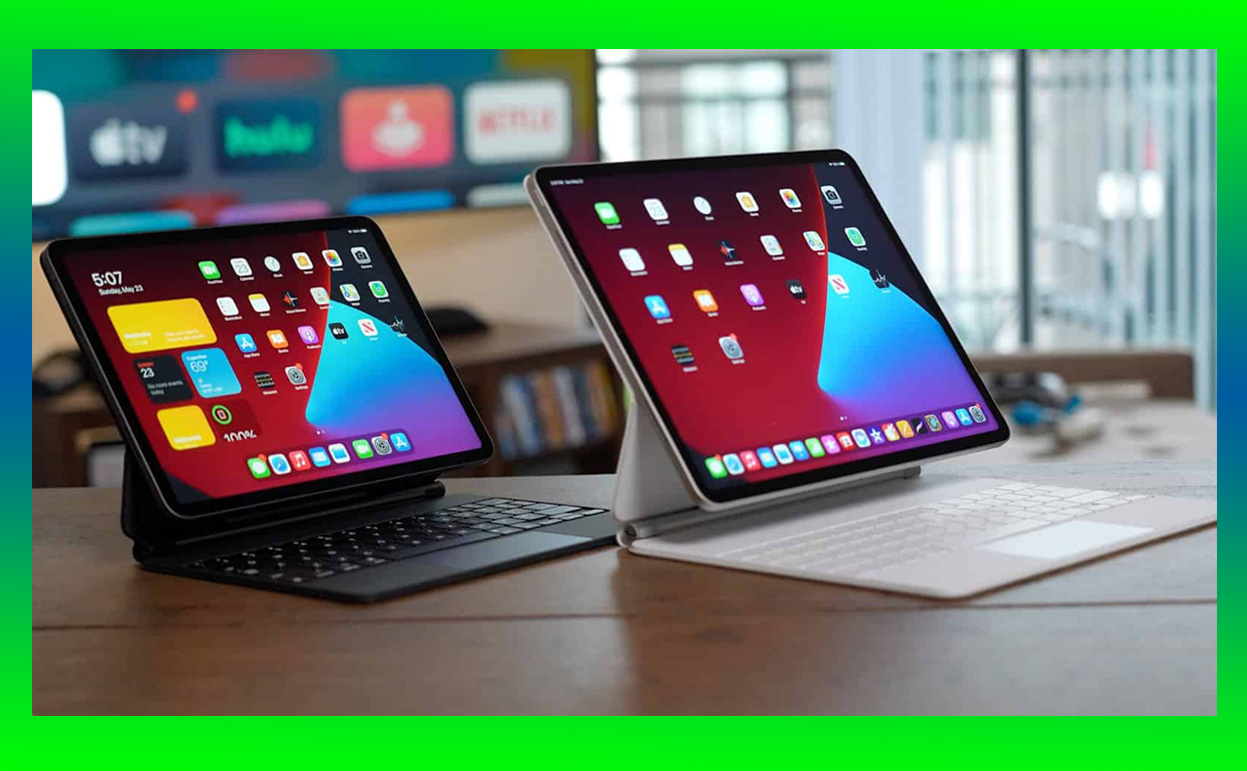Apple’s iPad has undergone significant transformations since its initial release in 2010, becoming a multi-functional powerhouse that meets the demands of diverse users. Each generation has brought new capabilities and refinements, pushing the boundaries of what a tablet can do. Let’s take a closer look at each generation and what it contributed to the iPad’s legacy.

1st Generation: The Original iPad (2010)
- Key Features: 9.7-inch LED-backlit display, A4 processor, 256MB RAM, up to 64GB storage, 10-hour battery life.
- Significance: The first iPad was a groundbreaking device that introduced a new category in personal computing. It was primarily used for browsing, media consumption, and reading, with a straightforward, user-friendly interface that appealed to a wide audience. Although lacking a camera, it quickly gained popularity for its portability and ease of use.
2nd Generation: iPad 2 (2011)
- Key Features: Dual-core A5 processor, thinner design, front and rear cameras, Smart Cover compatibility, 512MB RAM.
- Significance: The iPad 2 was faster, slimmer, and more capable than its predecessor. With the addition of front and rear cameras, FaceTime support, and a refined design, it appealed even more to students and educators. This model became a staple in education due to its affordability and functionality.
3rd Generation: iPad with Retina Display (2012)
- Key Features: Retina Display with 2048×1536 resolution, A5X processor with quad-core graphics, 5MP rear camera, LTE support.
- Significance: The 3rd-generation iPad introduced Retina Display, which was four times sharper than previous displays, setting a new standard for screen quality. It made reading, watching videos, and browsing more immersive. The addition of LTE support also marked the beginning of enhanced connectivity options for the iPad.
4th Generation: iPad (2012)
- Key Features: A6X processor, Lightning connector, improved graphics performance, 1GB RAM.
- Significance: Released just months after the 3rd generation, the 4th-generation iPad was more of a performance upgrade. With the faster A6X chip and the new Lightning connector, it was optimized for power users who wanted more speed for apps and games. This generation further established the iPad as a capable productivity tool.
iPad Mini (2012)
- Key Features: 7.9-inch display, A5 processor, thinner and lighter design.
- Significance: Apple introduced the iPad Mini as a smaller, more portable option, targeting users who wanted a compact device. Its smaller size and lower price made it ideal for one-handed use, appealing to younger audiences and those who valued portability.
5th Generation: iPad Air (2013)
- Key Features: 64-bit A7 processor, thinner and lighter design, M7 coprocessor.
- Significance: The iPad Air marked a shift toward a more lightweight and powerful design. With the 64-bit A7 chip, it offered improved performance and efficiency, making it more suited for multitasking. Its thin form factor set a design standard that later iPads would follow.
iPad Mini 2 with Retina Display (2013)
- Key Features: Retina Display, A7 chip, improved graphics.
- Significance: The iPad Mini 2 brought the same Retina Display quality found in larger iPads to a smaller form factor, making it one of the most compact high-resolution tablets on the market. It solidified the iPad Mini’s popularity among users who wanted a powerful yet portable device.
6th Generation: iPad Air 2 (2014)
- Key Features: A8X processor, 2GB RAM, laminated display, thinner design.
- Significance: The iPad Air 2 was even slimmer and lighter, with a laminated display that reduced glare and made content appear closer to the surface. With its A8X chip, it was optimized for graphics-intensive tasks, making it popular among creatives and gamers.
iPad Pro 12.9-inch (2015)
- Key Features: 12.9-inch display, A9X processor, Apple Pencil support, Smart Connector.
- Significance: The introduction of the iPad Pro marked Apple’s foray into the professional tablet market. With Apple Pencil and Smart Keyboard support, it became a powerful tool for artists, designers, and professionals who needed a capable device for creative and productivity tasks.
iPad Pro 9.7-inch (2016)
- Key Features: Smaller 9.7-inch Pro model, improved color accuracy, True Tone display.
- Significance: This model offered the Pro experience in a more portable size. It introduced True Tone technology, which adjusts the display’s color temperature to match ambient lighting, making it comfortable for extended use. It also expanded Apple Pencil support, making it accessible to more users.
7th Generation: iPad (2019)
- Key Features: 10.2-inch display, A10 Fusion chip, Smart Connector.
- Significance: The 7th generation iPad offered a larger display than its predecessors, along with Smart Connector support, making it compatible with Apple’s Smart Keyboard. Its affordability made it one of the best value tablets on the market, especially for students and casual users.
iPad Pro (2020) with Magic Keyboard and Trackpad Support
- Key Features: A12Z Bionic chip, LiDAR scanner, 11-inch and 12.9-inch options, Magic Keyboard support.
- Significance: The 2020 iPad Pro was notable for its Magic Keyboard with trackpad support, which made it more of a laptop replacement. The inclusion of the LiDAR scanner opened up new possibilities in augmented reality, making it a unique tool for developers and designers.
iPad Air (2020) with A14 Bionic
- Key Features: A14 Bionic chip, 10.9-inch edge-to-edge display, Touch ID in power button.
- Significance: The 4th-generation iPad Air bridged the gap between the entry-level iPad and the iPad Pro, with a design resembling the Pro models. It was the first iPad to feature the A14 Bionic chip, offering excellent performance in a mid-range package, making it suitable for both students and professionals.
iPad Pro (2021) with M1 Chip
- Key Features: M1 chip, Mini-LED display on 12.9-inch model, 5G connectivity.
- Significance: The M1 chip brought MacBook-level performance to the iPad, setting a new standard for power and efficiency in a tablet. The 12.9-inch model introduced a Mini-LED display, delivering stunning contrast and color accuracy, appealing to photographers, videographers, and visual artists.
iPad Mini (2021) with A15 Bionic
- Key Features: A15 Bionic chip, 8.3-inch Liquid Retina display, USB-C, Apple Pencil 2 support.
- Significance: This redesigned iPad Mini brought a modern, edge-to-edge display and impressive power with the A15 chip. USB-C connectivity and support for the 2nd-gen Apple Pencil made it a favorite among users seeking both portability and functionality.
iPad (2022): 10th Generation
- Key Features: A14 Bionic chip, 10.9-inch display, landscape front camera, USB-C.
- Significance: The 10th-generation iPad introduced a redesigned, colorful look, larger display, and landscape orientation for the front camera, optimizing it for video calls. USB-C connectivity made it compatible with a broader range of accessories.
iPad Pro (2022) with M2 Chip
- Key Features: M2 chip, Wi-Fi 6E, hover detection for Apple Pencil.
- Significance: The latest iPad Pro with the M2 chip continued pushing the limits of what a tablet can do, offering even more processing power, faster wireless capabilities, and improved Apple Pencil functionality. It’s currently the top choice for professionals who need a mobile device with desktop-like power.
Each generation of the iPad has expanded its functionality, making it adaptable to new use cases and technology demands. The latest models, with M-series chips and advanced display technology, show Apple’s commitment to innovation and suggest the iPad will continue to evolve in exciting ways. This comprehensive overview provides a deeper understanding of the iPad’s development, establishing its place as a leader in the tablet market.
Also Check:
- Are Roku TVs Worth It? Pros, Cons, and Key Features Explained
- Why Roku Wireless Speakers are the Perfect Addition to Your TV Setup
- USB-C on the iPhone 16 Is a Win for Everyone and it’s Easy to…
- Apple iPhone 16 Pro Max – Do Size Really Matter?
- Apple iPhone 16 Pro Max: A Clear And Unbiased Review About iPhone 16 Pro…
